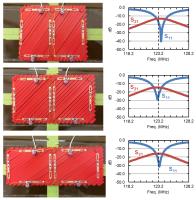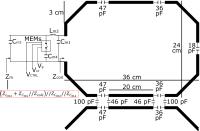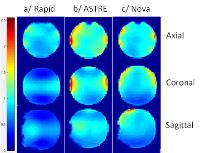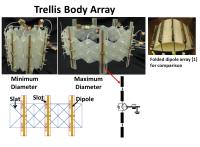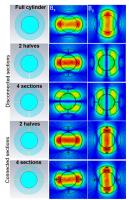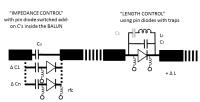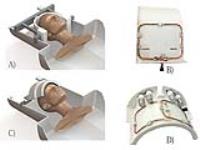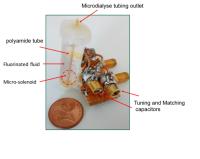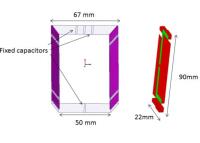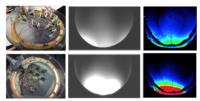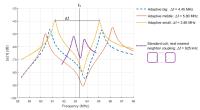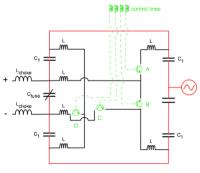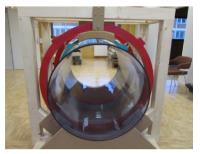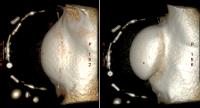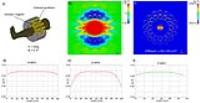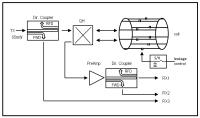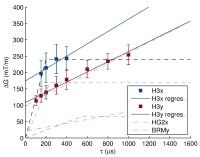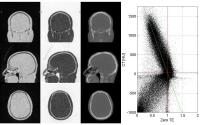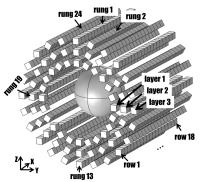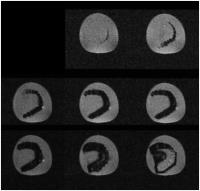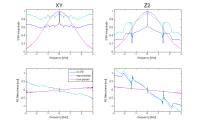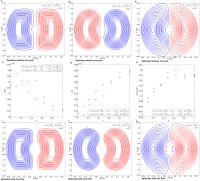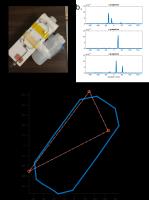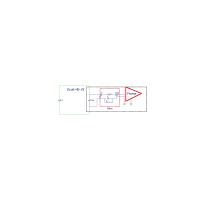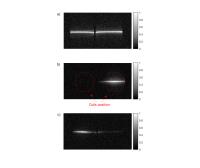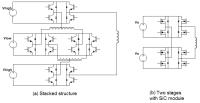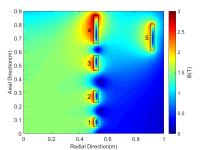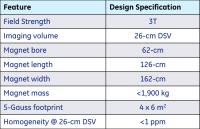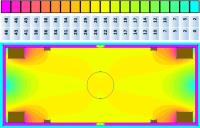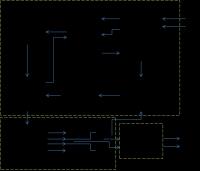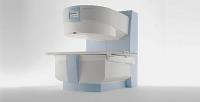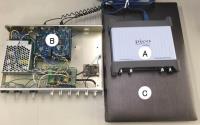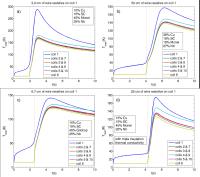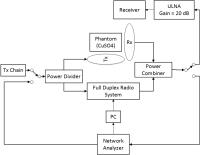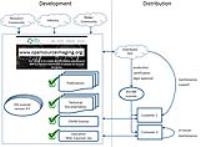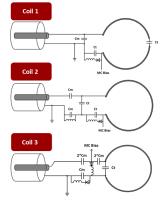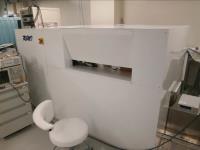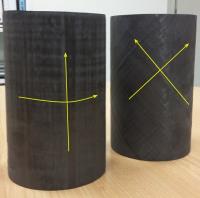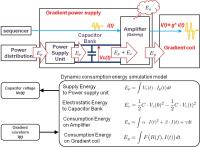|
Exhibition Hall 16:00 - 17:00 |
|
|
|
Computer # |
|
3524.
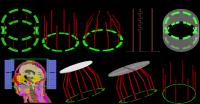 |
49 |
Dipole Array Design Considerations for Head MRI at 10.5T 
Jinfeng Tian1, Russell Lagore1, Lance
Delabarre1, and J. Thomas Vaughan1
1U. of Minnesota, Minneapolis, MN, United States
An 8-channel dipole array is a promising structure for human
head imaging at 10.5T. In order to optimize the structure
for efficiency and homogeneity over the brain, many
variations of the dipole were numerically simulated and
compared. The variations include varying dipole lengths,
warping the dipole, adding shielding, adding dielectric
padding or dielectric mirrors and including decoupling
capacitors. Compared to a design in use, numerical results
predict the RF homogeneity can be greatly improved with a
210 mm dipole array while simultaneously lowering the peak
local 1 gram and 10 gram SAR.
|
|
3525.
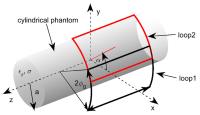 |
50 |
Analytical Modeling of the Coupling within a Human Head Surface
Loop Transmit Phased Array at Ultra-High Fields 
Nikolai I Avdievich1, Andreas Pfrommer1,
Ioannis Giapitzakis1, and Anke Henning1,2
1High-field Magnetic Resonance, Max Planck
Institute for Biological Cybernetics, Tübingen, Germany, 2Institute
for Biomedical Engineering, UZH and ETH Zurich, Zurich,
Switzerland
Decoupling of multi-channel ultra-high field (>7T)
transmit and transceiver arrays is a major issue. Analytical
modeling of the coupling can facilitate the array
optimization. We developed an analytical model describing
the impedance matrix for two rectangular loops placed on a
cylindrical surface and mimicking the human head array
geometry. The developed model was comprehensively validated
and allows for the optimization of the geometry and
positioning of the loops. The latter enabled simultaneous
cancellation of resistive and inductive coupling without
additional decoupling circuits. The resulting overlapped
array element arrangement improves both transmit and receive
performance in comparison to conventional gapped arrays.
|
|
3526.
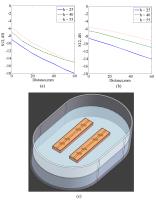 |
51 |
Optimization of the antenna-subject spacing for transceive
surface arrays of dipole antennas at 7T 
A.A. Hurshkainen1, I.J. Voogt2, A.A.
Haghnejad2, D.W. Klomp2, P.R. Luijten2,
I.V. Melchakova1, S.B. Glybovski1,
C.A.T. van den Berg2, and A.J.E. Raaijmakers2
1Department of Nanophotonics and Metamaterials,
ITMO University, Saint-Petersburg, Russian Federation, 2Imaging
Division, UMC Utrecht, Utrecht, Netherlands
Dipole antennas are being used increasingly for body imaging
at 7T. For dipole antennas, SAR levels can be reduced by
increasing the antenna-subject spacing. However, this will
increase inter-element coupling. In this study we
investigate the relationship between antenna-subject
spacing, inter-element coupling and maximum local SAR levels
for fractionated dipole antennas. We demonstrate that the
originally presented antenna-subject spacing (2 cm) can be
increased without significant scattering losses. We have
realized an 8-element array of fractionated dipole antennas
with 4 cm antenna-subject spacing and demonstrate
uncompromised imaging performance with 45% lower local SAR
levels in comparison to the original design.
|
|
3527.
 |
52 |
Evaluation of through-time radial GRAPPA for real-time cardiac
MR imaging at 7 Tesla 
Sascha Brunheim1,2, Sören Johst1,
Stefan Maderwald1, Stefan Rietsch1,2,
Stephan Orzada1, Marcel Gratz1,2,
Juliane Goebel3, Kai Nassenstein3,
Nicole Seiberlich4, and Harald H. Quick1,2
1Erwin L. Hahn Institute for Magentic Resonance
Imaging, University Duisburg-Essen, Essen, Germany, 2High
Field and Hybrid MR Imaging, University Hospital Essen,
Essen, Germany, 3Department
of Diagnostic and Interventional Radiology and
Neuroradiology, University Hospital Essen, Essen, Germany, 4Department
of Biomedical Engineering, Case Western Reserve University,
Cleveland, OH, United States
Accelerated radial data acquisition of the myocardium in
combination with through-time radial GRAPPA offers the
opportunity for real-time visualization of cardiac motility
without the need for additional ECG or pulse wave
synchronization. This is particularly useful in an
ultrahigh-field MR environment where conventional gating
methods in combination with cardiac dysrhythmia tend to
fail. In this work, the performance of through-time radial
GRAPPA against an established Cartesian k-space encoding
protocol featuring pulse-triggered cine-FLASH has been
evaluated and its role as an alternative for real-time
cardiac 7-Tesla MR imaging is shown.
|
|
3528.
|
53 |
Enabling axial diffusion tensor imaging of the human cervical
spinal cord at 7T 
Aurélien Massire1,2, Pierre Besson1,2,
Maxime Guye1,2, Jean-Philippe Ranjeva1,2,
and Virginie Callot1,2
1Centre de Résonance Magnétique Biologique et
Médicale (CRMBM), UMR 7339, CNRS, Aix-Marseille Université,
Marseille, France, 2Centre
d'Exploration Métabolique par Résonance Magnétique
(CEMEREM), Hôpital de la Timone, Pôle d’imagerie médicale,
AP-HM, Marseille, France
MRI at 7T has recently demonstrated its ability to provide
high-quality anatomical images of the spinal cord (SC), yet
no diffusion tensor imaging (DTI) study was reported so far.
Single-shot echo-planar imaging (ss-EPI) is the method of
choice for DTI but the sequence is seriously limited by
strong susceptibility artifacts. This work demonstrates that
a thoughtful implementation of ss-EPI at 7T combined with
distortion correction post-processing from two acquisitions
with opposed phase-encoding directions can generate
high-resolution axial DTI images of the cervical SC with
added value compared to lower field standard protocols
making SC DTI ready for UHF clinical investigations.
|
|
3529.
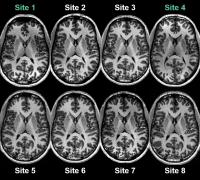 |
54 |
The traveling heads: Qualitative and quantitative evaluation of
multicenter brain imaging at 7 Tesla 
Maximilian N. Voelker1, Oliver Kraff2,
Daniel Brenner3, Astrid Wollrab4,
Oliver Weinberger5, Moritz C. Berger6,
Simon Robinson7, Wolfgang Bogner7,
Christopher Wiggins8, Robert Trampel9,
Tony Stöcker3, Thoralf Niendorf5,10,
Harald H. Quick2,11, David G. Norris2,12,
Mark E. Ladd2,6, and Oliver Speck4,13
1Erwin L. Hahn Institute for Magnetic Resonance
Imaging, University Hospital Essen, University of
Duisburg-Essen, Essen, Germany, 2Erwin
L. Hahn Institute for Magnetic Resonance Imaging, University
of Duisburg-Essen, Essen, Germany, 3German
Center for Neurodegenerative Diseases (DZNE), Bonn, Germany, 4Otto-von-Guericke-University,
Magdeburg, Germany, 5Berlin
Ultrahigh Field Facility (B.U.F.F.), Max-Delbrueck-Center
for MolecularMedicine, Berlin-Buch, Germany, 6Medical
Physics in Radiology, German Cancer Research Center (dkfz),
Heidelberg, Germany, 7High
Field MR Center, Department of Biomedical Imaging and
Image-guided Therapy, Medial University of Vienna, Vienna,
Austria, 8ScanNexus,
Maastricht, Netherlands, 9Max
Planck Institute for Human Cognitive and Brain Sciences,
Leipzig, Germany, 10Experimental
and Clinical Research Center, a jointcooperation between the
Charité Medical Faculty and the Max Delbrück Center for
MolecularMedicine, Berlin, Germany,11High Field
and Hybrid MR Imaging, University Hospital Essen, University
Duisburg-Essen, Essen, Germany, 12Donders
Centre for Cognitive Neuroimaging, Nijmegen, Netherlands, 13Leibniz
Institute for Neurobiology, Magdeburg, Germany
The “traveling heads” is an experiment started in 2014 to
assess the comparability and reproducibility of multicenter
human brain imaging at 7T. This is of particular interest as
7T MRI is currently being discussed to become a clinical
system in the very near future. The number of installations
continues to increase, with currently approximately 60
research sites in operation worldwide. As an advantage, this
new technology provides higher SNR, yet the
artifact-to-noise ratio is also increased. This can
influence the image quality severely and may be different at
individual UHF sites, where system hardware differences
could diminish reproducibility.
|
|
3530.
 |
55 |
Very high order B0 Shimming of the human brain at 9.4 T
considering Real B0 Shim Fields 
Paul Chang1,2, Sahar Nassirpour1,2,
and Anke Henning1,3
1Max Planck Institute for Biological Cybernetics,
Tuebingen, Germany, 2IMPRS
for Cognitive and Systems Neuroscience, Eberhard Karls
University of Tuebingen, Tuebingen, Germany, 3Institute
for Biomedical Engineering, UZH and ETH Zurich, Zurich,
Switzerland
A highly homogeneous B0 field is essential if we are to
exploit the advantages of higher field strengths for MR
applications. In this work, we model the real field of each
shim channel of a 4th order shim system for a 9.4T MR system
for in vivo B 0 shimming
applications. Each shim channel is modelled at a range of
frequencies to account for the possibility of amplitude
nonlinearities. By modelling the fields generated by each
shim channel, we were able to achieve better shim qualities
than if perfect fields were assumed.
|
|
3531.
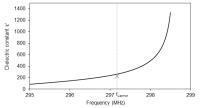 |
56 |
B1+ homogenization at 7T using an innovative meta-atom 
Lisa Leroi1, Alexandre Vignaud1,
Pierre Sabouroux2, Elodie Georget1,
Benoit Larrat1, Stefan Enoch2, Gérard
Tayeb2, Nicolas Bonod2, Alexis Amadon1,
Denis Le Bihan1, and Redha Abdeddaďm2
1UNIRS, CEA Saclay - DSV - I2BM - Neurospin -
UNIRS, Gif-sur-Yvette, France, 2CNRS,
Aix-Marseille Université, Centrale Marseille, Institut
Fresnel, UMR 7249, Marseille, France
B1+ heterogeneity
at ultra-high field (UHF) can be tackled performing “passive
shimming” with High-Dielectric Constant (HDC) pads.
Nevertheless, HDC pads have shown structural, manufacturing
and composition constraints. Here, we substitute HDC padding
with a new meta-atom (MA) structure with a high equivalent
dielectric constant, leaving behind the identified
limitations. In this work, we compare this MA structure to a
classic BaTiO3 pad
used in UHF clinical routine. Results demonstrate this
solution to strongly impact local B1+ distribution.
Implementing multiple MA structures into the coil design
might suggest a good potential for brain global B1+ inhomogeneity
mitigation.
|
|
3532.
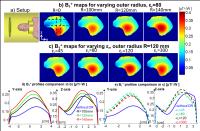 |
57 |
Improving travelling wave efficiency at 7 T using dielectric
material placed ”beyond” the region of interest 
Rita Schmidt1 and
Andrew Webb1
1Radiology, Leiden University Medical Center,
Leiden, Netherlands
The concept of traveling-wave MRI has been introduced for
ultra-high fields, enabling large field-of-view excitation
and physical separation between the antenna and the subject.
Several studies have shown that introducing additional
materials/structures into the magnet bore or surrounding the
subject can improve the efficiency. In this work we explore
the use of high permittivity material placed behind the
region of interest and show that it can be beneficial for
traveling wave efficiency. Separating the region of improved
efficiency from that of the dielectric allow positioning of
a receive array in the close proximity to the region of
interest, physically separate from the dielectric material.
|
|
3533.
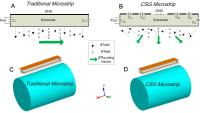 |
58 |
Tuning Microstrip Coil Field Patterns Using Capacitor-Segmented
Ground Planes 
Xinqiang Yan1,2, John C. Gore1,2,3,
and William A. Grissom1,2,3
1Institute of Imaging Science, Vanderbilt
University, Nashville, TN, United States, 2Radiology,
Vanderbilt University, Nashville, TN, United States, 3Biomedical
Engineering, Vanderbilt University, Nashville, TN, United
States
At 7T and higher, the B1 fields of loop and microstrip
coils become asymmetric. However, B1 fields of dipole
antennas are still symmetric. The different behaviors of
dipole and microstrip coils may be explained by the fact
that they have similar magnetic-field vectors but different
Poynting vectors. We propose to manipulate the Poynting
vector and thus the symmetry of the B1 patterns of
microstrip coils using capacitor-segmented ground (CSG)
planes. This concept has been validated by numerical studies
and practical MRI experiments. The CSG method provides
additional flexibility for manipulating the shape of the B1
field, which may be advantageous for RF shimming and
parallel transmission.
|
|
3534.
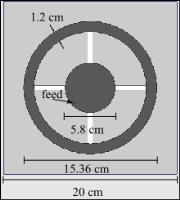 |
59 |
Control of Excited Modes in Ultra High Magnetic Field MRI with
Electrically Hard Surfaces 
Patrick Bluem1, Andrew Kiruluta2,
Pierre-Francois Van de Moortele3, Gregor Adriany3,
and Zoya Popovic1
1Department of Electrical, Computer, and Energy
Engineering, University of Colorado at Boulder, Boulder, CO,
United States, 2Massachusetts
General Hospital, Harvard Medical School, Boston, MA, United
States, 3University
of Minnesota, Center for Magnetic Resonance Research,
Minneapolis, MN, United States
Traditional MRI reactive near-field probe design for B1 field
uniformity assumes quasi-static fields. However, for B0>4T,
the quasi-static approximation is no longer valid since the
wavelength is smaller than the FOV and field wave modes
appear, affecting image quality. This work presents the use
of a copper strip waveguide structure combined with a
traveling wave excitation at 7T, 10.5T human wide-bore and
16.4T small animal scanners, while observing the effect on a
cylindrical distilled water phantom. A simple flexible
copper strip wearable wrap is shown to improve SNR and field
distribution in UHF-MRI.
|
|
3535.
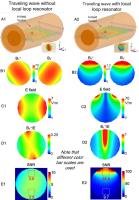 |
60 |
Theoretical and simulation verification of SNR enhancement in
traveling wave MRI using free local resonators 
Xinqiang Yan1,2 and
Xiaoliang Zhang3
1Institute of Imaging Science, Vanderbilt
University, Nashville, TN, United States, 2Radiology,
Vanderbilt University, Nashville, TN, United States, 3Department
of Radiology and Biomedical Imaging, University of
California San Francisco, San Francisco, CA, United States
Traveling wave MR is a promising method for large
field-of-view imaging at ultrahigh fields. However, a major
issue currently faced in traveling wave MR is low transmit
efficiency and limited SNR. It was found that the SNR in
traveling wave MRI can be significantly improved by using a
free local resonator. In this study, we validated this
finding in simulation and extended the single loop to a
multi-channel array. Based on the simulation results, the
SNR on the phantom has a 16-fold gain (56.8 VS 3.6) at near
area and 3-fold gain at far area (9.7 VS 3.5) with the help
of the free loop. This improvement can be attributed to the
secondary magnetic field caused by induced current of the
free resonator.
|
|
3536.
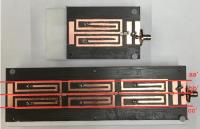 |
61 |
Zeroth-Order Resonator with Stepped Impedance for 7T Magnetic
Resonance RF Coil 
Vijayaraghavan Panda1,2, Sung-Min Sohn1,2,
Thomas J Vaughan1,2, and Anand Gopinath1
1Department of Electrical and Computer
Engineering, University of Minnesota, Minneapolis, MN,
United States, 2Department
of Radiology, Center for Magnetic Resonance Research,
Minneapolis, MN, United States
A planar structure based on a metamaterial transmission line
Zeroth Order Resonance (ZOR) and Stepped Impedance Structure
is designed as a MRI RF coil element. It generates high
uniform magnetic field in the 7T Magnetic resonance imaging
(MRI) system at 298 MHz, which improves the signal to noise
ratio and the quality of the images. The full wave
simulation and measurements show comparable results with the
microstrip TEM RF coil element [1]. Additionally, it can
generate uniform and high H-field intensity for any physical
length of the coil as the resonance of the ZORs is
independent of its length [2].
|
|
3537.
 |
62 |
9.4T Animal Scanner for Translation Research with Binary
Compatibility to Human Scanner and Clinical UI 
Jörg Felder1, Chang-Hoon Choi1, Stefan
Schwan1, A. Avdo Celik1, Seong Dae Yun1,
Nuno Andre da Silva1, Ana Maria Oros-Peusquens1,
and N. Jon Shah1,2
1INM-4, Forschungszentrum Jülich, Jülich,
Germany, 22Faculty
of Medicine, Department of Neurology, JARA, RWTH Aachen
University, Aachen, Germany
In translational research going from animal model to in vivo
human it is often desirable to change as few experimental
parameters as possible. For this purpose a unique 9.4 T
animal scanner has been assembled consisting of a dedicated
small bore magnet and being operated with clinical software.
Here we demonstrate an initial performance analysis of the
system as well as some more advanced image acquisitions.
|
|
3538.
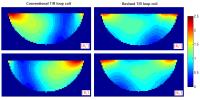 |
63 |
Revised Transmit/Receive Loop Coil for 7T Usage -
Permission Withheld
Zhiyong Zhai1 and
Michael Morich1
1Philips, Cleveland, OH, United States
At 7T, T/R loop coils have challenges in transmit B1+-field
efficiency and receive B1--field
sensitivity in a spatial context, due to the increased
tissue dielectric/wavelength effect. Here we propose a
revised T/R loop coil schema which improves the B1-field
non-uniformity at 7T. The proposed modification may make the
T/R loop coil construct yet more useful at ultra-high
fields.
|
|
3539.
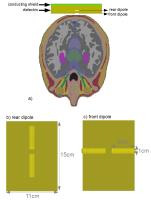 |
64 |
Feasibility of crossed-dipole antenna to excite a
circularly-polarized field for human brain imaging at 7T, A
design study 
Özlem Ipek1 and
Rolf Gruetter2,3,4
1CIBM-AIT, EPFL, Lausanne, Switzerland, 2LIFMET,
EPFL, Lausanne, Switzerland, 3Department
of Radiology, University of Lausanne, Lausanne, Switzerland, 4Department
of Radiology, University of Geneva, Geneva, Switzerland
The aim of this study was to investigate the crossed-dipole
antenna by means of electromagnetic simulations and compare
it with the surface quadrature head loop and volume head
coils in terms of B1+ efficiency
for 7T human brain imaging. The crossed-dipole antenna
consists of two dipoles placed in a crossed form mounted
upon/in an one-side conductor shielded dielectric. This
antenna excites the circularly-polarized field and enhances
the transmit efficiency in the occipital lobe in a larger
FOV compared to the conventional coils. The comparison of
the simulated B1+ maps
of the coils showed that it is feasible to build it.
|
|
3540.
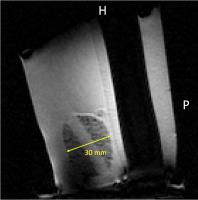 |
65 |
Traveling Wave MRI at 7T Using Dielectric Wave-Guide 
Zhiyue J Wang1,2, Alexander Ivanishev1,
Keith M Hulsey1, Dah-Jyuu Wang3, and
Robert E Lenkinski1
1UT Southwestern Medical Center, Dallas, TX,
United States, 2Children's
Medical Center Dallas, Dallas, TX, United States, 3Children's
Hospital of Philadelphia, Philadelphia, PA, United States
Traveling wave MRI uses a wave-guide for RF transmission.
The metal bore of the scanner magnet serves as a wave-guide
and extensions using conductor sheets may be added. Although
dielectric materials are frequently introduced into the
system, their intended function has been to modify the
behavior of the wave-guide. In this work, we show that a
dielectric material may be used as a wave-guide by itself,
in a fashion similar to optic fibers guiding light
transmission. We conducted MRI experiments at 7T using an
insulator wave-guide constructed by filling a PVC tube with
deionized water.
|
|
3541.
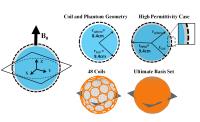 |
66 |
Optimizing high permittivity materials for SAR minimization in
transmit arrays: influence of the phase distribution of the
excitation profile 
Gillian G Haemer1,2,3, Manushka V Vaidya1,2,3,
Daniel K Sodickson1,2,3, Graham C Wiggins1,2,
and Riccardo Lattanzi1,2,3
1The Center for Advanced Imaging Innovation and
Research (CAI2R), Department of Radiology, New York
University School of Medicine, New York, NY, United States, 2The
Bernard and Irene Schwartz Center for Biomedical Imaging,
Department of Radiology, New York University School of
Medicine, New York, NY, United States, 3The
Sackler Institute of Graduate Biomedical Sciences, New York
University School of Medicine, New York, NY, United States
Appropriate high-permittivity, low-conductivity materials
placed between the RF coil and the sample can provide
performance improvement in both transmission and reception.
We employed a simulation framework based on dyadic Green’s
functions for multi-layered spherical geometries to analyze
how HPMs affect the tradeoff between excitation homogeneity
and global Specific Absorption Rate (SAR) for RF shimming at
7T using an L-curves analysis. Three target excitation
profiles were analyzed, with uniform amplitude and varied
phase, to determine the influence that target phase
distribution has on the optimal relative permittivity
results.
|
|
3542.
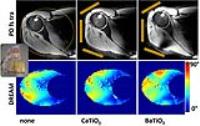 |
67 |
Evaluation of potential improvements from high permittivity pads
for imaging upper extremities at 7 Tesla 
Oliver Kraff1, Andrea Lazik-Palm1,2,
Wyger M Brink3, Andreas K Bitz4, Mark
E Ladd4, and Harald H Quick1,5
1Erwin L. Hahn Institute for MRI, University
Duisburg-Essen, Essen, Germany, 2Department
of Diagnostic and Interventional Radiology and
Neuroradiology, University Duisburg-Essen, University
Hospital, Essen, Germany, 3Radiology,
Leiden University Medical Center, Leiden, Netherlands, 4Medical
Physics in Radiology, German Cancer Research Center (DKFZ),
Heidelberg, Germany, 5High
Field and Hybrid MR Imaging, University Duisburg-Essen,
University Hospital, Essen, Germany
Two sets of dielectric pads with high permittivity (CaTiO3:
110 and BaTiO3: 286) were evaluated for potential
improvements in imaging the shoulder joint and upper arm in
combination with an 8–channel transmit/receive shoulder coil
at 7 Tesla. In vivo images with structural PD TSE and DREAM
flip angle maps were obtained and compared to measurements
without pads present. Both a fixed RF shim as well as
individual RF shimming were applied. For the investigated
configurations, no substantial improvements in imaging upper
extremities at 7 Tesla were found when applying high
permittivity dielectric pads.
|
|
3543.
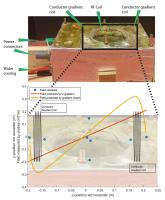 |
68 |
Characterization of a breast gradient insert coil at 7 tesla
with field cameras 
Tijl van der Velden1, Quincy van Houtum1,
Mark W.J.M. Gosselink1, Peter R Luijten1,
Vincent O Boer2, and Dennis W.J. Klomp1
1Radiology, UMC Utrecht, Utrecht, Netherlands, 2Danish
Research Centre for Magnetic Resonance, Copenhagen
University Hospital Hvidovre, Hvidovre, Denmark
In this work a gradient insert coil for breast MRI has been
constructed. Its behaviour inside a 7T whole body MR system
was characterized using magnetic field cameras. Furthermore,
the possibility to correct eddy currents from the gradient
insert coil using the built-in gradient set has been
investigated.
|
|
3544.
 |
69 |
Extending the Sensitivity of a Head Coil toward Simultaneous
Head and Neck Imaging Using High Permittivity Materials at 7 T 
Manushka V. Vaidya1,2,3, Gillian G. Haemer1,2,3,
Christopher M. Collins1,2,3, Gang Chen1,2,3,
Giuseppe Carluccio1,2, Mary Bruno1,2,
Graham C. Wiggins1,2, Daniel K. Sodickson1,2,3,
and Riccardo Lattanzi1,2,3
1Center for Advanced Imaging Innovation and
Research (CAI2R), Department of Radiology, New York
University School of Medicine, New York, NY, United States, 2Bernard
and Irene Schwartz Center for Biomedical Imaging, Department
of Radiology, New York University School of Medicine, New
York, NY, United States, 3Sackler
Institute of Graduate Biomedical Sciences, New York
University School of Medicine, New York, NY, United States
A standard head-coil may not be sufficient to examine
regions inferior to the base of the skull. Previous work
demonstrates that the field-of-view of a surface coil can be
extended using high permittivity materials (HPM). In this
work, we use calcium titanate bags to extend the sensitivity
of a commercial head-coil, and demonstrate an increase in
the signal-to-noise ratio in the neck muscles, brainstem and
superior regions of the spinal cord and cervical vertebrae.
Our results indicate that extending the sensitivity of any
commercial coil may be possible using appropriately
positioned HPMs.
|
|
3545.
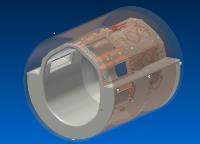 |
70 |
7T 8-channel pTx head coil with high B1+ efficiency optimized
for MRS 
Frank Seifert1, Harald Pfeiffer1, Ralf
Mekle1, Patrick Waxmann1, and Bernd
Ittermann1
1Physikalisch-Technische Bundesanstalt (PTB),
Braunschweig and Berlin, Germany
A 7T 8-channel transmit/receive head volume coil is
introduced which is capable to produce transmit fields in
the human brain of more than 50 µT necessary for single
voxel MRS with acceptable chemical shift artifacts. Key to
this good transmit field efficiency was careful design and
material selection but also the choice of relatively short
coil elements. From the simulation based design process
appropriate input power limits were concluded which allow
safe operation of the coil in compliance with IEC
60601-2-33.
|
|
3546.
 |
71 |
On the robustness and reproducibility of spatially selective
excitation using parallel transmission at 7T – a multicenter
study - Permission Withheld
Maximilian N. Voelker1, Daniel Brenner2,
Martina Flöser3, Marcel Gratz4,5,
Soeren Johst4, Stephan Orzada4, Tony
Stöcker2, Harald H. Quick4,6, Mark E.
Ladd3,4, and Oliver Kraff4
1University of Essen, Erwin L. Hahn Institute for
Magnetic Resonance Imaging, Essen, Germany, 2German
Center for Neurodegenerative Diseases (DZNE), Bonn, Germany, 3Medical
Physics in Radiology, German Cancer Research Center (dkfz),
Heidelberg, Germany, 4Erwin
L. Hahn Institute for Magnetic Resonance Imaging, University
of Duisburg-Essen, Essen, Germany, 5High
Field and Hybrid MR Imaging, University Hospital Essen,
University of Duisburg-Essen, Essen, Germany, 6High
Field and Hybrid MR Imaging, University Hospital Essen,
University Duisburg-Essen, Essen, Germany
Parallel transmission (pTx) allows the excitation of
arbitrarily shaped patterns or reduced field-of-view imaging
and is of particular interest in ultra-high field MRI where
it is used to diminish artifacts caused by B1
inhomogenities. However, calculation of arbitrarily shaped
pulses is not included in standard pTx system procedures, is
time consuming, and can only be done with knowledge of
additionally acquired transmit B1 fields. To optimize this
workflow, it might be advantageous to share pre-calculated
pulses between different systems and/or coils. Image
patterns were generated and optimized to assess image
quality and to evaluate reproducibility and robustness of
shared pulses.
|
|
3547.
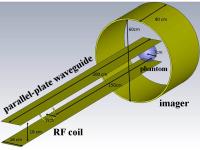 |
72 |
Simulated phase of driving voltage for travelling wave MRI with
a parallel-plate waveguide at 7 T -
Video Not Available
Fabian Vazquez1, Sergio Solis1,
Rodrigo Martin1, and Alfredo O Rodriguez2
1Physics Department, Faculty of Sciences, UNAM,
Mexico, DF, Mexico, 2Dep
Electrical Engineering, UAM Iztapalapa, Mexico DF, Mexico
Travelling wave magnetic resonance imaging (twMRI)
offers to overcome the inhomogeneities due to the standing
wave patterns, and the use of coil arrays with multiple coil
elements. The excitation of the spins have been commonly
done with RF surface coils, dipole and patch antennas, etc.
The resonant device should be able to generate an adequate
magnetic field to transmit the signal to a distant object
using a waveguide. In this paper, we numerically simulated
the magnetic field of the principal mode (TM0) as
a function of the driving voltage phase.
|
|



